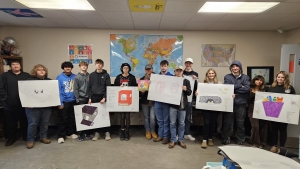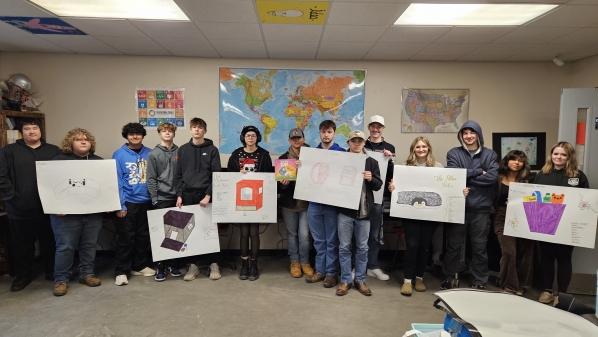Students and educators throughout western North Carolina know all too well the impact Hurricane Helene has had on their communities. Not only were many personally impacted by the physical destruction the storm left in its wake, but so many of our students and teachers continue to see the emotional toll that the storm has taken on everyone in the region. As soon as many residents were able, they were jumping into action to help with recovery efforts. It was with this mindset that Thelma Kastl, engineering teacher at West Wilkes High School, initiated a project with her students aimed at creating and building preparation kits that could be distributed to Hurricane Helene victims in need or to assist in any future crisis. The message from the book they read, All We Need is Love and a Really Soft Pillow was the guiding principle. The book allowed the students to solve a real-life problem using human-centered design, and as a teacher in the GREAT STEM Program (part of the Empowering Teacher Learning (ETL) program that supports high school teachers), Mrs. Kastl was able to incorporate this microbadge to help tie it all together.
Students engineered a variety of creations, and their prototypes were made with items they had in the classroom. One team took apart an old donated computer to see if they could figure out the electrical voltage converter to turn it into a way to charge phones or small batteries. One student addressed the lack of phone communication and decided that children might want to write to their friends. Another group of students created a video-game-controller-themed supply box. Each student’s design was unique and heartfelt.
We asked Thelma Kastl to tell us more about her project and the impact it had on her students:
What prompted this project? Hurricane Helene and a book that I randomly purchased in September but did not read until about three weeks after Helene struck North Carolina. I often use picture books intended for a much younger audience with my students. It ended up that this random purchase was the perfect introduction to a real-life solutionary lesson. The book is "All We Need is Love and a Really Soft Pillow."
What was the biggest takeaway by the students? What about you, as the instructor? The students were really very compassionate and wanted to actually talk with individuals who had been through the storm to get input about what would be valuable to anyone experiencing a disaster. I missed the week after the hurricane struck so that I could volunteer in Ashe County where I live. The students asked many questions about the things I saw and the people I helped. The combination of the actual storm, real-life stories and input from survivors, the book, and the challenge of trying to design something that would be beneficial, while also entertaining or helping to take someone's mind off of the tragedy they are experiencing, really allowed the students the opportunity to be involved, to be a solution, to see that a project can be more than just an assignment or grade.
For me, the biggest takeaway has been the pride the students had in trying to alleviate the pain and hardship others might experience during a disaster or tragedy. They wanted to make more than just a cardboard prototype. They wanted to actually be able to implement their solutions, and they wanted to be able to add more supplies to their projects than we were able to put in them. They had hoped they could make enough projects to send to Mountain View Elementary in Ashe County, because they did a demonstration there a few weeks after the hurricane, and the students at Mountain View are now our "engineering buddies." My students could have learned about human-centered design and real-world issues by following the example in my curriculum. I think this project will stay with them for the rest of their lives because they were proactively trying to help neighboring people in need.
How has Empowering Teacher Learning (ETL) and GREAT STEM supported you in this project? ETL has been a fabulous tool for me throughout this past year and this project. The resources provided are amazing. Everything is easily accessible. I have a wonderful coach, Erin West. She has been great at sending extra resources to me when I have asked.
Could you discuss how working on this project led you to think differently about your own experiences (as a teacher, as a resident of western NC, as a problem solver, or any other perspective)? Anytime I use a book I usually ask for a volunteer to read. This time, I read the book to the students. I cried through every page. Students had tears in their eyes, too. The book and the students working on this project was a catalyst for the grief I felt while volunteering and the weeks following. Watching and listening to the students brought me hope that sometimes teachers don't get to see. We often are so busy worrying about data and exam scores that we can't see that the students are capable of so much more than a multiple-choice evaluation. Teachers take all of the scrutiny to heart and feel like failures. Students take all of the scrutiny to heart and feel like failures. This disaster, this project, these wonderful caring students are not failures. They are a future that I can feel good about. They have compassion. They are solutionaries who will make the world better. I just need to give them more opportunities to shine and less multiple-choice responses.
Are there additional thoughts you’d like to share? I must say that this project was more than a lesson plan. These students used all of the tools from their previous classes and the new human-centered design approach to try to come up with the best possible solution. In addition, this project was an investment of heart, soul, and spirit for them and for me. We wish we could have done more.
Several students from Mrs. Kastl’s class spoke about their experiences,
Caleb said, “Coming together as a high school community to support hurricane victims shows the power of compassion and teamwork. It’s not just about providing aid; it’s about making a difference when it matters most."
Levi said, “I thought it was a really cool project to be able to work on; however, while I was working on it, just thinking of it as a project, we began to ask questions of the people in the situations, and it became a lot more real and made me personally want to work harder towards finishing it.”
Madison said, “It was mostly not about getting the grade, it was mostly about the kids for me. I like that Mrs. Kastl chose to do this for one of our assignments, and it showed that the other kids in class also cared about the kids that were affected by the hurricane.”
To view the prototypes and see the students discuss their creations, visit this Google folder.
Mrs. Kastl provided the completed projects to hurricane survivors in a neighborhood near Mountain View Elementary in Ashe County.

